At a shepherd's hut on Polonina Svidovec in the Transcarpathian Ukraine
July 23 and 24, 1998
Polonina = a treeless rounded or plane-like crest of a mountain ridge in the Carpathian Mountains
used for pasture for many centuries, during which time the tree line may have
been pushed down by intensive pasture and by man-made fires.
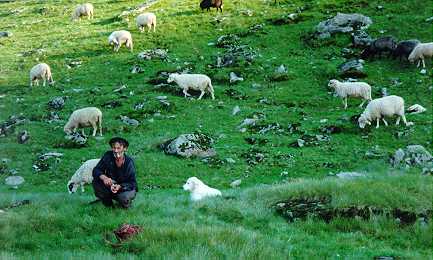 In the evening, when we were pitching our tents, this shepherd drove his herd by our camp
into the pen at his hut which was located further below our camp. He invited us to
come to visit his place. A few people from our group managed to do that right away
(unfortunately not me).
In the evening, when we were pitching our tents, this shepherd drove his herd by our camp
into the pen at his hut which was located further below our camp. He invited us to
come to visit his place. A few people from our group managed to do that right away
(unfortunately not me).
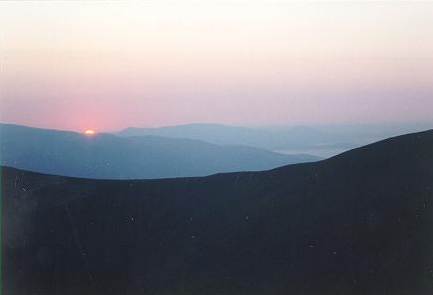 But I was able to wake up early in the morning and to climb before the sunrise
onto the crest of the Svidovec ridge above our camp. From there, I had this spectacular
view of the sunrise which took place at about 5:40. Our tents deep below
in front of the black ridge of the Svidovec Polonina (in the foreground) were still in a lot of darkness.
But I was able to wake up early in the morning and to climb before the sunrise
onto the crest of the Svidovec ridge above our camp. From there, I had this spectacular
view of the sunrise which took place at about 5:40. Our tents deep below
in front of the black ridge of the Svidovec Polonina (in the foreground) were still in a lot of darkness.
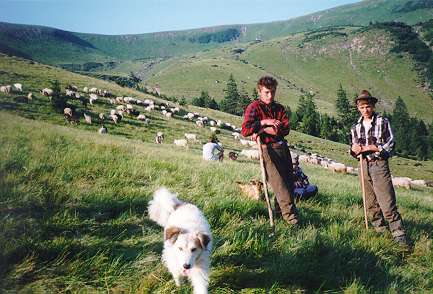 Then I descended back to the camp just in time to join the group who were ready
to make an early morning visit with the shepherd. On our way down to his hut
we met his young helpers who, having finished the morning milking, were already driving
the herd towards the crest of the polonina (in the background) for the pasture.
They milk the animals (manually) three times a day. For the midday milking they
will bring the whole herd of about 300 sheep and some goats back to the hut,
and then drive them up again for the afternoon pasture.
Then I descended back to the camp just in time to join the group who were ready
to make an early morning visit with the shepherd. On our way down to his hut
we met his young helpers who, having finished the morning milking, were already driving
the herd towards the crest of the polonina (in the background) for the pasture.
They milk the animals (manually) three times a day. For the midday milking they
will bring the whole herd of about 300 sheep and some goats back to the hut,
and then drive them up again for the afternoon pasture.
This herd was assembled of all the sheep and goats owned by people from one village.
Our shepherd and his helpers take care of all of them during the
three up to four summer months when the conditions are suitable for pasture
in high mountains (Polonina Svidovec lies at the elevation of between about 1500 to
1881 m above sea level).
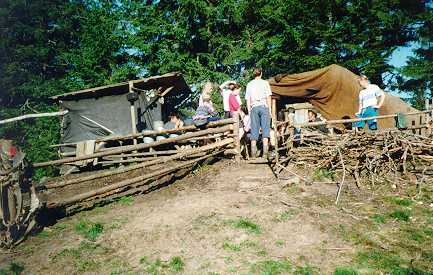 The hut consisted of two simple open shacks. The one on the right served as
a bedroom and for cheese production. At its front a fire is burning or at least
smoldering most of the time to keep the occupants warm at night, and to speed
up the process of cheese making during the day. The left shack serves as a
kitchen, pantry, equipment store and an eating place.
The hut consisted of two simple open shacks. The one on the right served as
a bedroom and for cheese production. At its front a fire is burning or at least
smoldering most of the time to keep the occupants warm at night, and to speed
up the process of cheese making during the day. The left shack serves as a
kitchen, pantry, equipment store and an eating place.
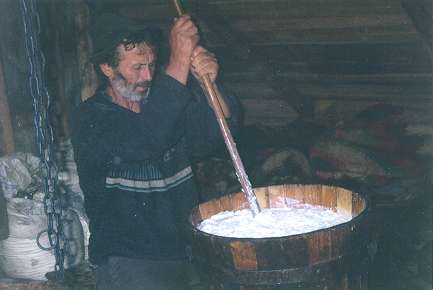 After the shepherd fed us with bread and very good soft curd cheese, which he
called bakshai in the local dialect, and with whey to flush it down,
he showed us how they make the cheese. This barrel contained initially about
all the milk gathered from the herd in a day. In this
picture the milk is already somewhat curdy after being warmed up by the fire
smoldering next to it for some time. A round board with holes is attached
perpendicularly to the end of that pole with which the shepherd is battering
the milk - it is about the same technology that my grandmother
(in Czechia) had still occasionally used for making butter out of cow milk only
some 45 years ago. The milk must be battered with this implement for a few hours
before the cheese is ready. Bakshai and whey are actually only the leavings
in the process of making the main product - large round blocks of hard cheese,
that are then being dried in sacks hanging from a beam suspended between the two shacks.
In the end, we bought one of these blocks. It proved to be full
of holes, and I personally liked the bakshai better.
After the shepherd fed us with bread and very good soft curd cheese, which he
called bakshai in the local dialect, and with whey to flush it down,
he showed us how they make the cheese. This barrel contained initially about
all the milk gathered from the herd in a day. In this
picture the milk is already somewhat curdy after being warmed up by the fire
smoldering next to it for some time. A round board with holes is attached
perpendicularly to the end of that pole with which the shepherd is battering
the milk - it is about the same technology that my grandmother
(in Czechia) had still occasionally used for making butter out of cow milk only
some 45 years ago. The milk must be battered with this implement for a few hours
before the cheese is ready. Bakshai and whey are actually only the leavings
in the process of making the main product - large round blocks of hard cheese,
that are then being dried in sacks hanging from a beam suspended between the two shacks.
In the end, we bought one of these blocks. It proved to be full
of holes, and I personally liked the bakshai better.
 Here you can see in the background also the sheep hides that serve the shepherd and his helpers
as a bed for at least three summer months. Only once a week one of them goes down
into the village to sell the dried cheese and to buy bread and other supplies.
Here you can see in the background also the sheep hides that serve the shepherd and his helpers
as a bed for at least three summer months. Only once a week one of them goes down
into the village to sell the dried cheese and to buy bread and other supplies.
|
This two-day hike to Polonina Svidovec was one of the highlights of a 10 day
trip that took us literally around the whole Transcarpathian Ukraine. It was organized
by Adventura, a travel
agency based in Prague, Czechia. We traveled by bus from Prague with a stop
in Slovakia's High Tatra mountains. Then we hiked almost every day in the
Ukrainian Carpathians, and our bus ferried us between the
end point of one hike and the starting point of the next day's hike.
We also did some sightseeing in the cities of Uzhhorod and Khust, and stopped in
many other places.
Here is a picture of our first camp on the Ukrainian
territory, just at a time when a herd of cows was returning through it in
the evening from the pasture to their village. Next morning we saw
these freely roaming horses at pasture on the crest of Bukovska Polonina.
We started our last, two-day, hike described above by a 50 km train ride on an old
narrow-gauge railway otherwise used nowadays only for hauling timber from the mountains.
Here is a view of the village of Brustary taken from this train.
Most of the village houses in Transcarpathia are made of wood, and are nicely designed.
|
|
Transcarpathia is a region of many natural beauties. It is a relatively small part of Ukraine,
separated from the main body of the country by the large bow of the Carpathian Mountains. Thus for most Ukrainians
it is beyond the Carpathians, that's why they call it the Transcarpathian Region.
For us Central Europeans (Slovaks, Czechs, Magyars, etc.), it is at the foot of
(and in front of) the Carpathians, that's why we call it Subcarpathia (or historically,
the Subcarpathian Rus). In English, it also used to be called Ruthenia.
Subcarpathia had a turbulent history. For about a thousand years it was part
of the Hungarian kingdom. Hungarians have sentimental memories of this place.
It is believed that it was here where the Hungarian tribes managed to
sneak through the Carpathian passes from the East, and built their first forts
from which they conquered their present homeland in the Danubean plane.
Since 1919, Subcarpathia was part of Czechoslovakia for 20 years. It played a
role in the works of some well-known Czech writers from that era, and is thus still today
the subject of the curiosity and a tourist destination of many Czechs and Slovaks.
One can hear many languages in the cities and towns of Subcarpathia, mainly Rusyn, Ukrainian,
Hungarian, Russian and Romani. Many people are multilingual. The inhabitants
of the countryside are mainly Rusyns, whose language (of three different dialects) many
consider to be a separate Slavic language. However, Rusyn has not yet been
recognized as an official language by any of the governments which ruled
Subcarpathia in the past or present. There were several unsuccessful movements in the past to
gain autonomy for Subcarpathia or to gain the official recognition for the Rusyn language.
During my short visit to Subcarpathia spent mainly in the mountains, I had no opportunity
to find out what the local people actually think about these questions.
They seemed to be mainly concerned about how to cope with the hardship of their
everyday life caused by the transformations their country has been undergoing in the last decade.
But one can find a lot of information about the Rusyn history and language on the
pages of the Carpatho-Rusyn center in the USA.
|
- Pictures made by another Czech hiker in 1995 on another Transcarpathian
polonina - Borzhava.
- And more pictures and information about Carpathian poloninas just across the border
from Transcarpathia in the Polish Bieszczadzki National Park.
|
 In the evening, when we were pitching our tents, this shepherd drove his herd by our camp
into the pen at his hut which was located further below our camp. He invited us to
come to visit his place. A few people from our group managed to do that right away
(unfortunately not me).
In the evening, when we were pitching our tents, this shepherd drove his herd by our camp
into the pen at his hut which was located further below our camp. He invited us to
come to visit his place. A few people from our group managed to do that right away
(unfortunately not me).
 But I was able to wake up early in the morning and to climb before the sunrise
onto the crest of the Svidovec ridge above our camp. From there, I had this spectacular
view of the sunrise which took place at about 5:40. Our tents deep below
in front of the black ridge of the Svidovec Polonina (in the foreground) were still in a lot of darkness.
But I was able to wake up early in the morning and to climb before the sunrise
onto the crest of the Svidovec ridge above our camp. From there, I had this spectacular
view of the sunrise which took place at about 5:40. Our tents deep below
in front of the black ridge of the Svidovec Polonina (in the foreground) were still in a lot of darkness.
 Then I descended back to the camp just in time to join the group who were ready
to make an early morning visit with the shepherd. On our way down to his hut
we met his young helpers who, having finished the morning milking, were already driving
the herd towards the crest of the polonina (in the background) for the pasture.
They milk the animals (manually) three times a day. For the midday milking they
will bring the whole herd of about 300 sheep and some goats back to the hut,
and then drive them up again for the afternoon pasture.
Then I descended back to the camp just in time to join the group who were ready
to make an early morning visit with the shepherd. On our way down to his hut
we met his young helpers who, having finished the morning milking, were already driving
the herd towards the crest of the polonina (in the background) for the pasture.
They milk the animals (manually) three times a day. For the midday milking they
will bring the whole herd of about 300 sheep and some goats back to the hut,
and then drive them up again for the afternoon pasture.
 The hut consisted of two simple open shacks. The one on the right served as
a bedroom and for cheese production. At its front a fire is burning or at least
smoldering most of the time to keep the occupants warm at night, and to speed
up the process of cheese making during the day. The left shack serves as a
kitchen, pantry, equipment store and an eating place.
The hut consisted of two simple open shacks. The one on the right served as
a bedroom and for cheese production. At its front a fire is burning or at least
smoldering most of the time to keep the occupants warm at night, and to speed
up the process of cheese making during the day. The left shack serves as a
kitchen, pantry, equipment store and an eating place.
 After the shepherd fed us with bread and very good soft curd cheese, which he
called bakshai in the local dialect, and with whey to flush it down,
he showed us how they make the cheese. This barrel contained initially about
all the milk gathered from the herd in a day. In this
picture the milk is already somewhat curdy after being warmed up by the fire
smoldering next to it for some time. A round board with holes is attached
perpendicularly to the end of that pole with which the shepherd is battering
the milk - it is about the same technology that my grandmother
(in Czechia) had still occasionally used for making butter out of cow milk only
some 45 years ago. The milk must be battered with this implement for a few hours
before the cheese is ready. Bakshai and whey are actually only the leavings
in the process of making the main product - large round blocks of hard cheese,
that are then being dried in sacks hanging from a beam suspended between the two shacks.
In the end, we bought one of these blocks. It proved to be full
of holes, and I personally liked the bakshai better.
After the shepherd fed us with bread and very good soft curd cheese, which he
called bakshai in the local dialect, and with whey to flush it down,
he showed us how they make the cheese. This barrel contained initially about
all the milk gathered from the herd in a day. In this
picture the milk is already somewhat curdy after being warmed up by the fire
smoldering next to it for some time. A round board with holes is attached
perpendicularly to the end of that pole with which the shepherd is battering
the milk - it is about the same technology that my grandmother
(in Czechia) had still occasionally used for making butter out of cow milk only
some 45 years ago. The milk must be battered with this implement for a few hours
before the cheese is ready. Bakshai and whey are actually only the leavings
in the process of making the main product - large round blocks of hard cheese,
that are then being dried in sacks hanging from a beam suspended between the two shacks.
In the end, we bought one of these blocks. It proved to be full
of holes, and I personally liked the bakshai better.
 Here you can see in the background also the sheep hides that serve the shepherd and his helpers
as a bed for at least three summer months. Only once a week one of them goes down
into the village to sell the dried cheese and to buy bread and other supplies.
Here you can see in the background also the sheep hides that serve the shepherd and his helpers
as a bed for at least three summer months. Only once a week one of them goes down
into the village to sell the dried cheese and to buy bread and other supplies.